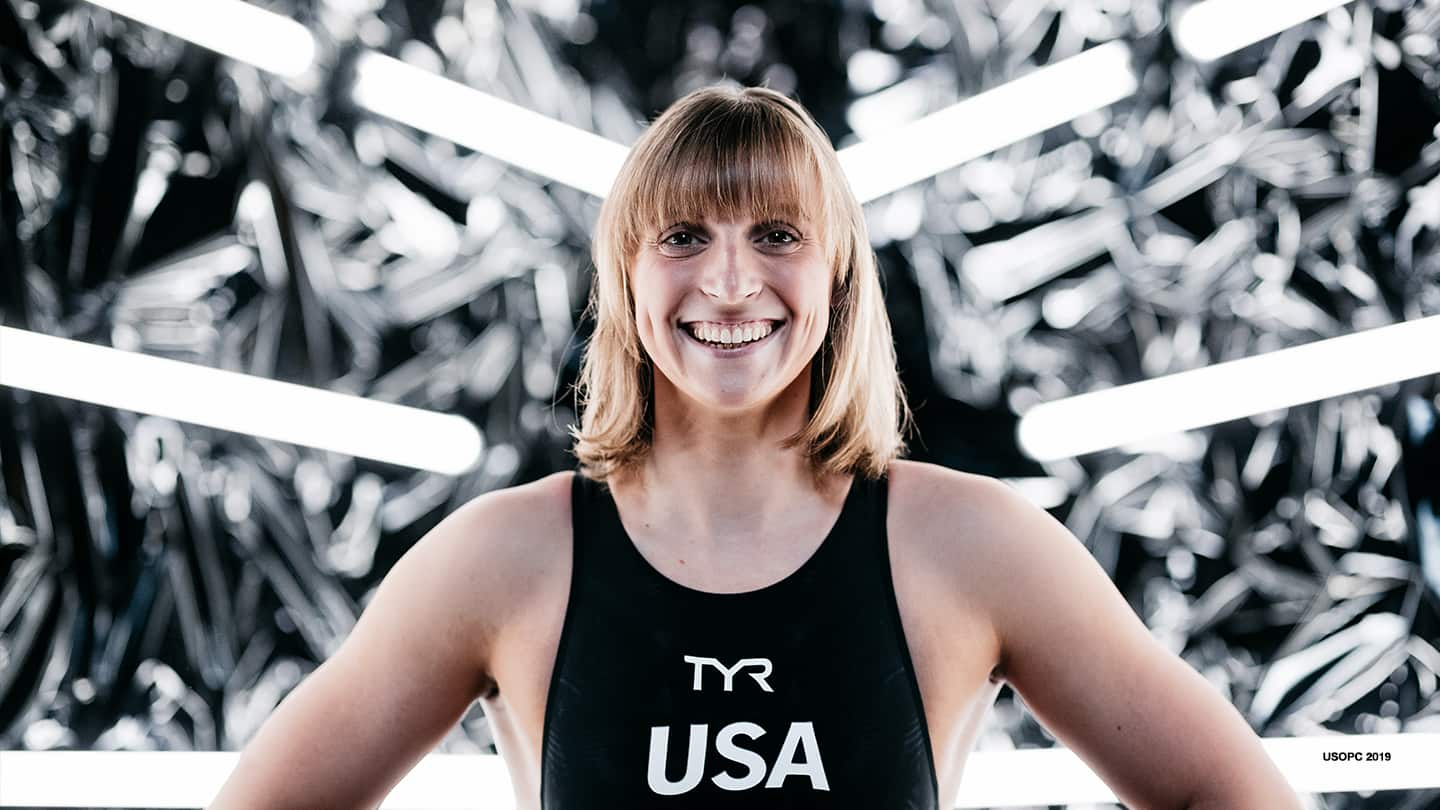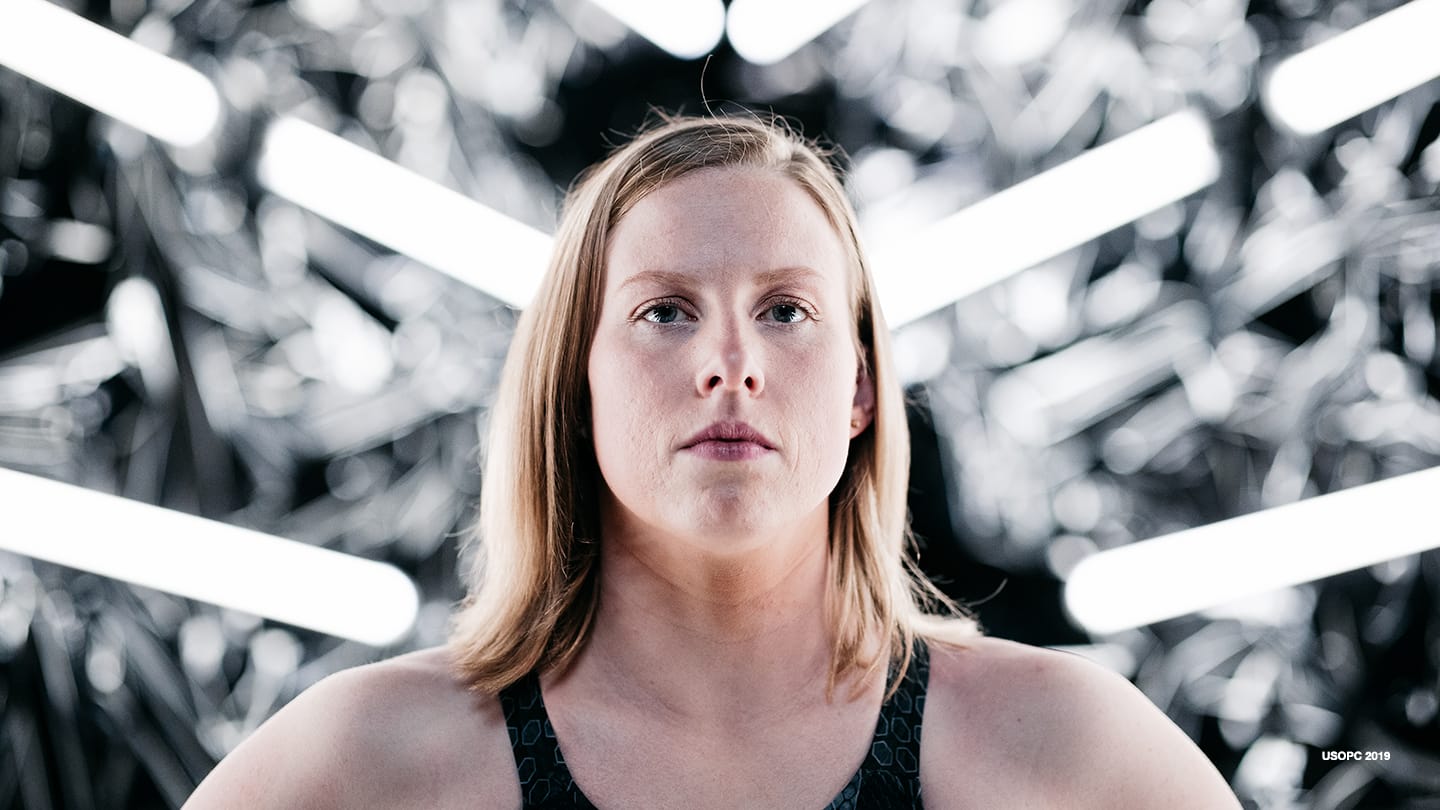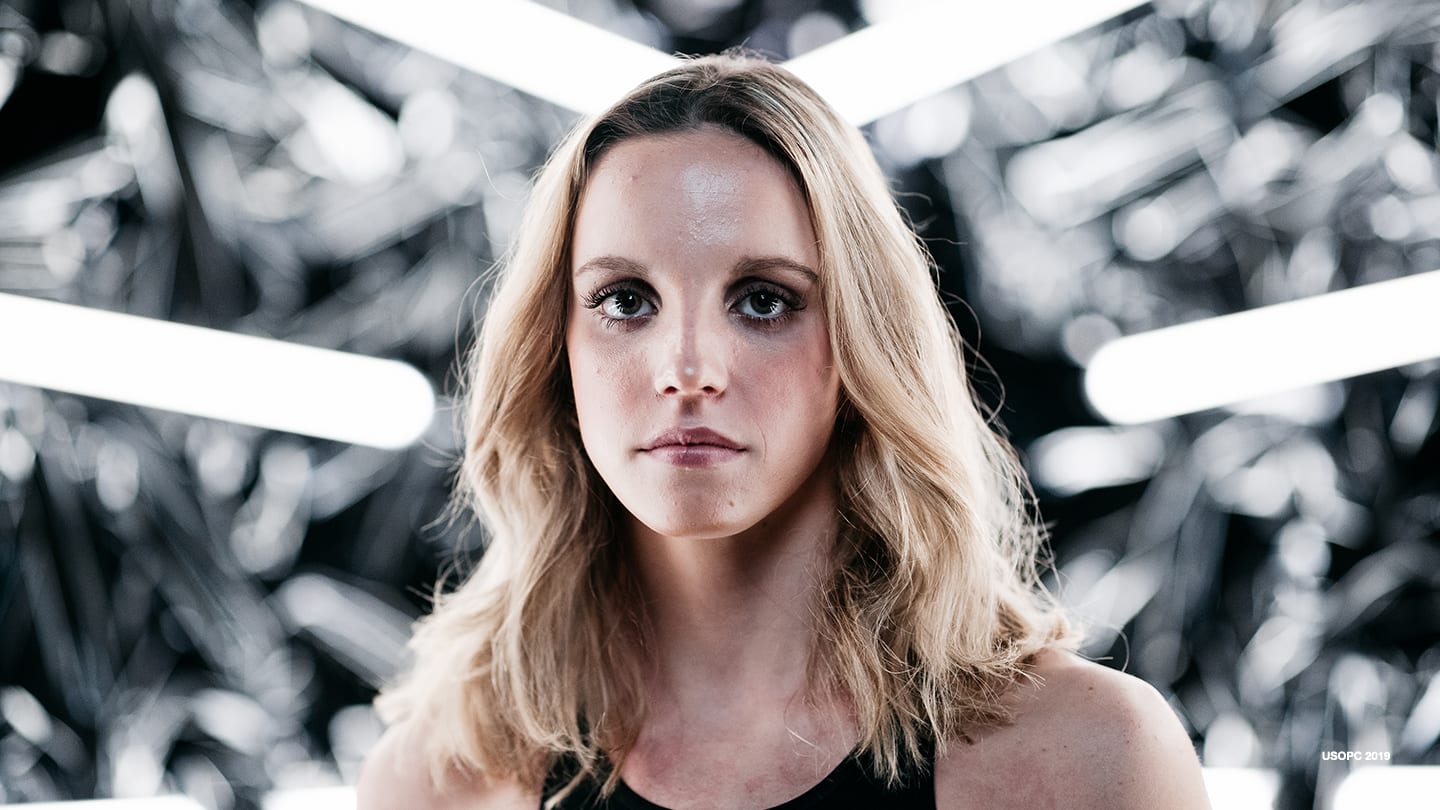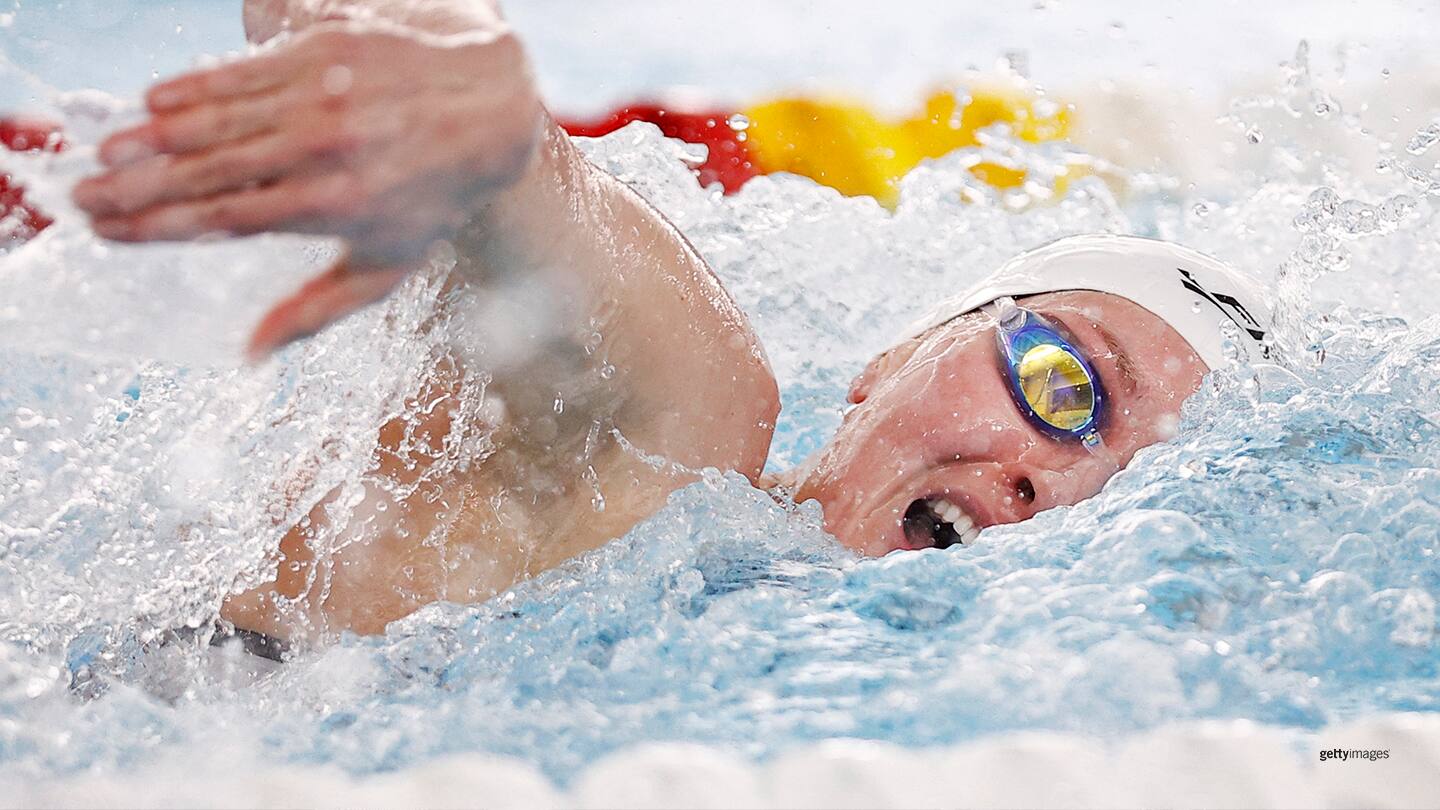
A Look At Athletes And Storylines To Watch At Swimming’s U.S. Olympic Team Trials
by Peggy Shinn

Katie Ledecky poses during the Team USA Tokyo 2020 Olympic shoot on Nov. 23, 2019 in West Hollywood, Calif.
Who to Watch presented by DeVry is a series that includes a run-down on the front runners, dark horses, unexpected athletes and top storylines to watch during Trials.
America’s top swimmers will dive into the pool for U.S. Olympic Team Trials at the CHI Health Center Omaha in Omaha, Nebraska, starting this weekend. Due to Covid-19 restrictions, trials for swimming have been divided into two waves this year, with Wave I swimmers trying to qualify for Wave II.
Wave I will be held June 4-7, with the top two swimmers per race qualifying for Wave II, which runs June 13-20.
During Wave II, the top two finishers in each race, plus additional athletes for the freestyle relays, will secure spots on the 2020 U.S. Olympic Team.
The Olympic Games Tokyo 2020 are the first Games in this millennium without Michael Phelps on the U.S. roster. But twenty-five Olympic gold medalists are back, including Olympic veterans Matt Grevers, Nathan Adrian, Anthony Ervin, Allison Schmitt, and Ryan Lochte—who, should they qualify for Tokyo, would become three-time (Grevers), four-time (Adrian, Ervin, Schmitt) and five-time Olympians (Lochte). Collectively, these five swimmers currently own an astounding 22 Olympic gold medals and 37 total Olympic medals.
Challenging these veterans and the defending Olympic gold medalists will be a host of fast up-and-comers, as well as several 2016 Olympians aiming for gold.
Here’s a look at some of the swimmers to watch and storylines to keep an eye on at next week's trials. The Who To Watch series is presented by DeVry.

Lilly King poses during the Team USA Tokyo 2020 Olympic shoot on November 23, 2019 in West Hollywood, California.
Katie Ledecky
Ledecky is in a class by herself. The 24-year-old distance freestyler is a shoo-in to make her third U.S. Olympic Team in four individual races: the 200-, 400-, 800-, and the 1,500-meter freestyle races, the latter which makes its Olympic debut in Tokyo. Ledecky is the defending Olympic gold medalist in the 200, 400, and 800. In her career, she has broken 14 world records—and counting—and currently holds three world records (400, 800, 1,500). Of note, with the addition of the 1,500 to her schedule, Ledecky will not compete in the 100 freestyle this year. At the Olympic Games Rio 2016, she competed in the 4x100 freestyle relay, helping the U.S. win an Olympic silver medal. Should she win five gold medals in Tokyo, Ledecky will have tallied 10 Olympic gold medals and 11 total (to date), making her the winningest female Olympian and second behind Phelps.
Ryan Murphy
At the 2016 Rio Games, Ryan Murphy, 25, swept the men’s backstroke races and broke the world record in the 100 back. He also led the U.S. to gold in the 400 medley relay. Since then, he has not won an international race. But he is still one of the fastest backstrokers in the world and his times are on track for another world-record performance in the 100 back. In the U.S., no other backstrokers are—yet—in his league. But at the Olympic Games Tokyo, Murphy will face stiff international competition.
Simone Manuel
A breakout star in Rio, Manuel became the first Black swimmer to win an Olympic gold medal when she tied for first in the 100 freestyle. She also won silver in the 50 freestyle. Now the 24-year-old is poised for more medals in Rio. She’s the defending world champion in both the 50 and 100 freestyle, and should she qualify for her second Olympic Games, she will likely anchor the women in both the 4x100 freestyle and medley relays, and the mixed relay as well. She anchored the U.S. team to gold in the mixed relay at the 2019 world championships. The mixed relay makes its Olympic debut in Tokyo.
Lilly King
Few outside of swimming had heard of Lilly King before she wagged a finger at, then took down Russian rival Yulia Efimova in the 100 breaststroke at the Rio Games. King, now 24, has not been defeated in the 100 breaststroke (long course) since 2015 and is almost a lock to win that race at trials and in Tokyo as well. She is less of sure-thing in the 200 breaststroke, which she won at 2016 trials and swam in Rio but did not advance to the final. Still, her 200 is now looking stronger, and she recently swam a 2:21.82 for the 200 (the fifth fastest time in the world this year going to trials), just ahead of training teammate Annie Lazor, who’s currently ranked eighth in the world in the 200.

Regan Smith at the Team USA Tokyo 2020 Olympic shoot on November 23, 2019 in West Hollywood, California.
Caeleb Dressel
Since Michael Phelps retired from swimming after the 2016 Rio Games, Caeleb Dressel, 24, has been dubbed the next great. In Rio, Dressel was still an up-and-comer, winning gold in the 4x100 freestyle relay and finishing sixth in the 100 freestyle (his one individual race). Now Dressel is poised for stardom. He won seven medals at the 2017 world championships, then an astonishing eight medals—a record-breaker—at 2019 worlds while setting a world record in the 100 butterfly. He’s already listed as a favorite to win three individual races in Tokyo (100 fly, 100 and 50 freestyle) and will most likely compete for the U.S. in the 4x100 freestyle relay, medley, and mixed relays. Most recently, Dressel—swimming for the Cali Condors—was named MVP of the International Swimming League last fall. Over the course of two days, he broke short-course world records in the 50-meter freestyle, 100 fly, and 100 IM.
Regan Smith
Regan Smith burst onto the scene at 2017 nationals when, as a 15-year-old, she finished second to Olympic silver medalist Kathleen Baker in the 200-meter backstroke. Nationals that year were a world championship qualifier, and at worlds that year, Smith made it to the 200 backstroke final, finishing eighth. A month later, she became junior world champion in both the 100 and 200 back. The next summer, she earned a bronze medal in the 200 back at the 2018 Pan Pacific Championships—her first medal at a major international meet—then really made a name for herself at 2019 world championships, where she shattered Missy Franklin’s 200-meter backstroke world record and also set the 100 back world record as the lead-off swimmer in the women’s medley relay. Now 19, Smith is facing stiffer competition in the 200 back, with 18-year-old Phoebe Bacon beating her at the most recent TYR Pro Swim Series meet in mid-May. In other events, Smith is currently the third-ranked 100 backstroker in the U.S. but the second ranked in the 200 butterfly. Look for her to contest these three races at trials, then have a breakout Olympic Games.

Olivia Smoliga competes at theTYR Pro Swim Series on January 17, 2021 in San Antonio, Texas.
Hali Flickinger
At the Rio Games, Hali Flickinger finished seventh in the women’s 200 butterfly and was one of the few U.S. swimmers who did not bring home an Olympic medal. Now, the 26-year-old is the best 200 butterflier in the U.S., and she is also currently ranked third in the world. Since the Rio Games, she has won a gold medal in the 200 fly at 2018 Pan Pacs and a silver at 2019 worlds just ahead of teammate Katie Drabot, a Stanford graduate and 2018 Pan Pac and 2019 worlds bronze medalist in the 200 fly.
Jay Litherland
Jay Litherland, 25, finished fifth in the 400 individual medal at the Rio Olympic Games, just under five seconds behind teammate Chase Kalisz who won the silver medal. A year later, at the 2017 world championships, Litherland—one of triplet brothers who all swam for the University of Georgia—finished fifth again in the 400 IM. But at 2019 worlds, Litherland swam down favorite Daiya Seto from Japan, finishing just 0.27 of a second behind Seto for the silver medal. Most recently, Kalisz and Litherland were 1-2 at the first TYR Pro Swim Series meet in 2021 and at the Atlanta Classic in mid-May. But University of Texas freshman Carson Foster, 19, could take them both down. In late May, Foster swam a blistering 4:11.13—over two seconds ahead of Kalisz’s fastest time so far this year and the fourth fastest in the world to date.
Melanie Margalis
A 2016 Olympic gold medalist in the 4x200 freestyle relay, Margalis is a versatile swimmer who excels in both the 200 and 400 IMs. But in the 200, she has had a string of fourth place finishes: at the 2016 Olympic Games (behind teammate Maya DiRado who won bronze), and at both the 2017 and 2019 world championships. Lately, the 29-year-old has been coming on strong in the 400 IM—considered the decathlon of swimming. She won a silver medal at 2018 Pan Pacs—her first international (long-course) medal in an individual event. A year ago, just before the Covid-19 lockdown, she dropped almost three seconds from her 400 IM time. This year, at the TYR Pro Swim Series meet in April, she swam the third fastest time in the world so far this year, beating her nearest competition by over two seconds. It could be the year that Margalis says good-bye to fourth place and hello to the podium.
Olivia Smoliga
As a 21-year-old, Olivia Smoliga qualified for her first Olympic Games in 2016 in the 100-meter backstroke. Back then, she was in awe of the U.S. women’s backstroke domination at the Olympic Games and did not yet feel up to the challenge. She finished sixth in Rio, then won an Olympic gold medal leading off the women’s medley relay in the prelims. Fast forward five years, and Smoliga has matured mentally and physically. Now 26, she is currently the third ranked 100-meter backstroker in the world, a world championship bronze medalist (2019), and is definitely ready for the challenge of winning an Olympic medal this go-round.

Michael Andrew poses during the Team USA Tokyo 2020 Olympic shoot on November 23, 2019 in West Hollywood, California.
Michael Andrew
With a unique training method called Ultra Short Race Pace Training (USRPT), Michael Andrew broke over 100 national age group records when he was younger and turned pro in 2013 at age 14. But he missed making the 2016 U.S. Olympic Team, and his first medal at an international long-course meet was a gold in the 50 free at 2018 Pan Pacs. At the 2019 world championships, Andrew’s best finish in an individual race was fourth (50 free), and he only won one medal: a silver in the 4x100 free relay. This year will likely be a different story for 22-year-old Andrew. At a TYR Pro Swim Series meet in mid-May, Andrew became the top ranked U.S. swimmer this year in the 100 breaststroke, 100 butterfly, and 200 IM. And his 100 fly time put him second in the world ahead of reigning world champion Caeleb Dressel.
Phoebe Bacon
As a freshman at the University of Wisconsin this year, 18-year-old Bacon became the 2021 NCAA 200-yard backstroke champion. Then at a meet in mid-May, she swam the third-fastest 200 back time in the world this year, making her the top-ranked American in the stroke going to trials ahead of world record holder Regan Smith. Bacon will also likely contend in the 100 back as well; she’s the 2019 Pan Am gold medalist at that distance, and she finished third at 2021 NCAAs in the 100-yard back. This will be Bacon’s second trip to trials. In 2016, as a 13-year-old, she was reportedly the youngest swimmer competing at U.S. Olympic Team Trials—Swimming. Bacon is also a friend of Katie Ledecky’s. The two attended the same elementary schools in Bethesda, Maryland, with Ledecky serving as Bacon’s “big buddy” in pre-school. But the two swam for different clubs in Maryland.
Shaine Casas
A senior at Texas A&M, Shaine Casas is ready for a breakout performance at the U.S. Olympic Team Trials—Swimming. The 21-year-old has never competed in an international swim meet, but he won the 100-meter backstroke at 2019 nationals with the fifth fastest time in the world that year, just 0.38 of a second behind Olympic champion Ryan Murphy. Most recently, Casas won 2021 NCAA titles in the 100- and 200-yard backstrokes, as well as the 200 IM. His time in the 200-yard backstroke was the second fastest in history—behind Murphy’s time set at 2016 NCAAs. At trials, look for Casas to challenge in both the 100 and 200 backstroke races, the 200 IM, and even the 200 freestyle. One day soon, he would like to compete on the men’s 4x200 freestyle relay. With such versatility, Casas is on course to become one of the next great American swimming champions.
Madisyn Cox
Madisyn Cox, 25, is perhaps the best American swimmer who has never swum at an Olympic Games (she finished fourth in both the 200 and 400 IMs at 2016 U.S. Olympic Team Trials—Swimming). An all-arounder, she is currently ranked first in the world in the 200 IM, fifth in the world (and second in the U.S.) in the 400 IM, and she could very try for a relay spot in the 200 freestyle as well. A 2017 world championship bronze medalist in the 200 IM, Cox was suspended for six months after failing a test for performance-enhancing drugs (the Court of Arbitration for Sport determined that the substance was in her multivitamins, so she ingested it unknowingly), so she missed the 2019 world championships. With that debacle behind her, Cox is on track to qualify for the Tokyo Games and be a medal favorite ther. She swam her best 200 IM on May 22, 2021—in 2:08.51, third best ever for an American and over two-tenths faster than Maya DiRado’s bronze-medal-winning time in Rio.
Had covid-19 not postponed the Tokyo Olympic Games, Curzan might have made the 2020 U.S. Olympic Team. But then as a 15-year-old, the teenager might have chalked the Games up as experience. Now, Curzan is a favorite to qualify in the 100 butterfly and to medal in Tokyo in that event. Swimming in her home pool in North Carolina in April, she clocked 56.20 in the 100 fly—the eighth fastest time ever and second fastest by an American swimmer behind Dana Vollmer, the 2012 Olympic gold medalist in the 100 fly and 2016 bronze medalist. A four-time medalist at the 2019 world junior championships, Curzan will likely also challenge in the 50 and 100 freestyles (she currently holds the fourth fastest time in the world this year in the 50 free and is currently ranked No. 2 for the U.S. in the 100 free behind fellow teen sensation Torri Huske). Curzan is also on the list of 100 backstroke favorites. Since April, Curzan, now 16, has dropped over a second off her personal best in the 100 back. But it will be one of the tougher races at trials, with several favorites battling it out for the two Olympic spots. And currently Curzan is the fourth-ranked American in the 100 backstroke in 2021.